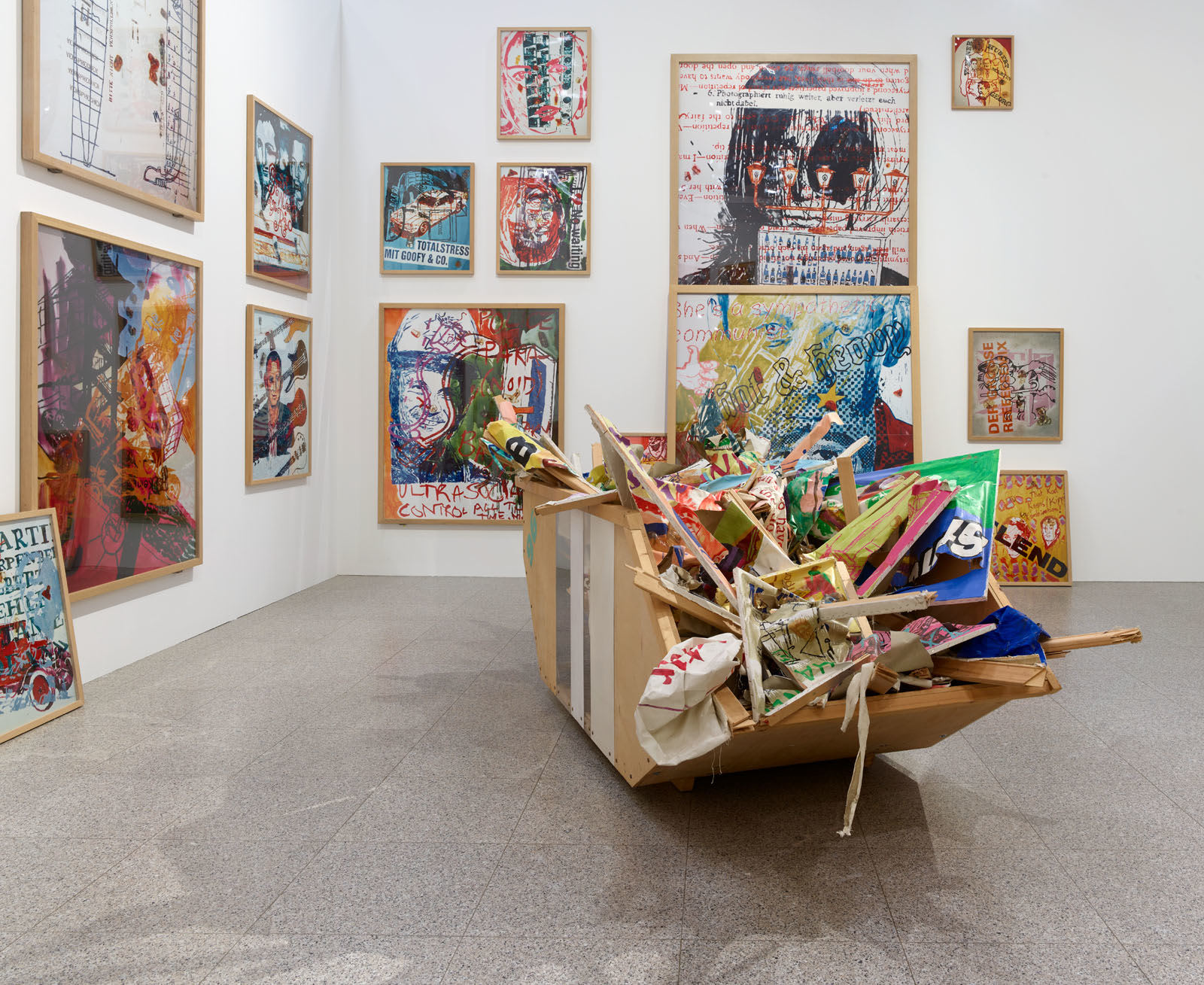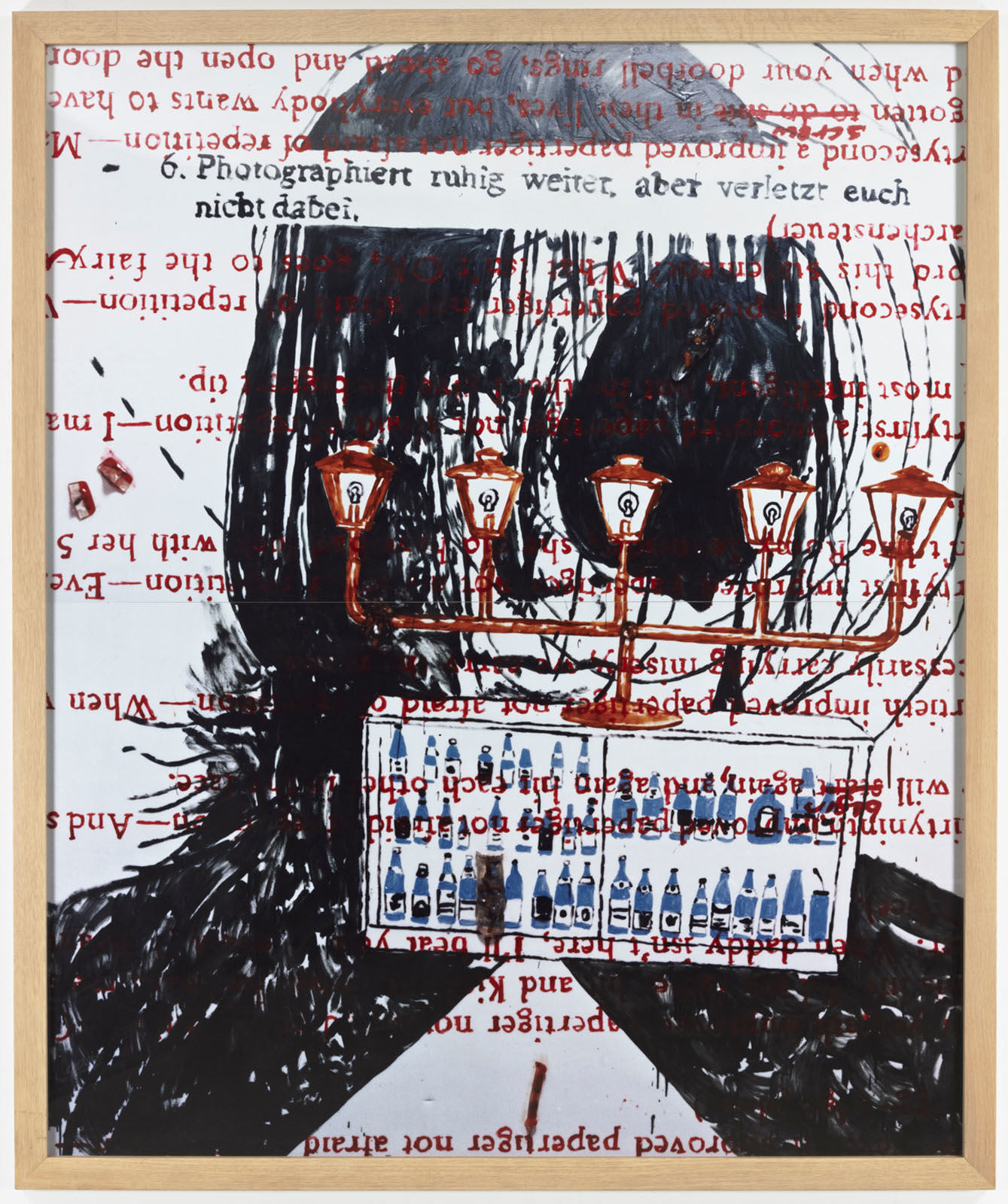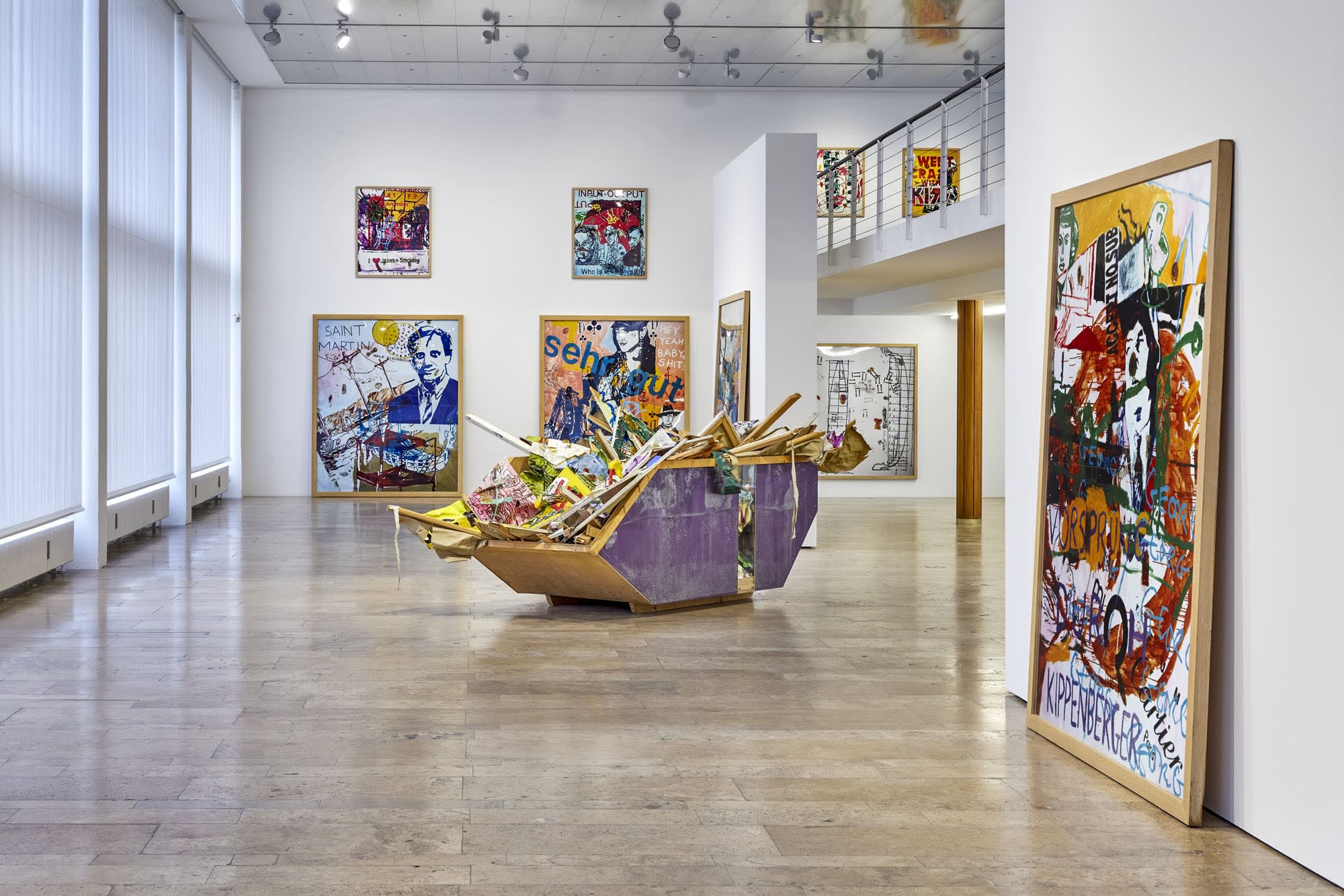Martin Kippenberger: Heavy Burschi
Heavy Burschi comes across as a “heavy guy” who, weighing upon his shoulders, is saddled with guilt. The myth of his creation precedes him: a self-built dumpster made of plywood, crammed with smashed oil canvases, literally showcases the annexation of works finished by the skilled hands of someone else – as disposable art. It is as if Martin Kippenberger (1953–1997) had destroyed them himself in an adolescent fit of competitive envy. More than any other, this installation first presented in 1991 at the Kölnischer Kunstverein preserves Kippenberger’s regressive genesis of replication and valorization, in defiance of artistic sanctimonious visions of originality, authorship, or even sovereignty.
We can see here what Jan Avgikos once described in a review of the “heavy guy” as a “problems in art.” Instead of executing the paintings in the dumpster himself, Kippenberger commissioned his assistant Merlin Carpenter to repaint them from reproductions published in earlier catalogues. However, the commissioner was not satisfied with the copies that Carpenter ultimately reworked into his own painting collages. They seemed too painterly, even too perfect: “Just too good, too skillful, and therefore too much kitsch, these paintings. So I decided to make them double-kitsch.” (Kippenberger)
Before Kippenberger had all fifty-one original oil paintings destroyed, he photographed, printed, and framed them in their original sizes, so that they could be exhibited in an “advanced stage of valorization” along with the dumpster. The collages, brimming with Kippenberger’s self-referentiality, corrupt painting as a higher craft pandering to the lowest common denominator and counter virtuoso showmanship with a “low materialism” (Julia Gelshorn). Rather than the shiny plastic casings of consumerism, here it is their regurgitated particles that titillate our eyes: a tangled semiosis contaminated by everyday clutter, pairing anti-jokes from advertising and pop snippets, trademarks, and political symbols. With their cigarette butts enclosed in cast-resin figurines on the two-dimensional pictorial surfaces, which look like a giveaway gimmick from popular German teen-magazine BRAVO, these particles are more likely to evoke nausea than consumer appeal. As painterly immanence is put through the meat grinder and the last spark of faith in art on a social mission is extinguished, multiple Kippenberger selves embroiled in mundane scandalous headlines shake hands: with a guitar on his neck, posing as Saint Martin, covered in BMW logos, or joined by his American artist counterpart Koons under the headline “ELEND” (MISERY). And finally, Andy Warhol next to Albert Oehlen shouldn’t be missed in this “input-output.
Heavy Burschi exemplarily embodies the carefully choreographed self-design of Kippenberger – the myth-enshrouded functional model of the “Kippenberger assistance” contributing still to this day. It included friends and fellow artists who performed “services” on behalf of their commissioner at the bar or at his office “Kippenberger Büro,” which he founded with Gisela Capitain in 1978. Carpenter once referred to this strategy of charisma-based exploitation as the “secret explainer” of aesthetics. Having someone else execute the work meant assimilating mishaps, or rather productive instances of misinterpretation in the form of outside intervention – a kind of public image disturbance from within one’s artistic genre suicide – where the artist-subject, the work, and the social realm mutually butcher each other into “new hybrid forms” (Diedrich Diederichsen).
As the series Lieber Maler male mir (1981) or the exhibition Peter (1987), titled with a surrogate suffix, Heavy Burschi shows the self-betrayal of the anything-goes calculus of a “dilettante.” At the same time, the “Kippenberger assistance” is at work as a legendary potency of one’s authorship, which even posthumously continues to have an effect.
Kippenberger did seem to be aware that the Romantic myth of the genius artist is no better than the idea of artists as workers, revolutionaries, or even entrepreneurs – art myths rooted in those of (white, male, “productive”) universality (Dave Beech). As a free-spirited and not infrequently brutal universal artist, art figure, and private person, as well as a “wastrel, long-time painter, ringleader, lodger, liaison-facilitator, hypervoyeur, show-off” (as he put it on a poster on the occasion of his 25th birthday), he unabashedly exposed his own inadequacies and those belonging to such categories time and again in favor of thinking in terms of networks, like a fuming factory of social connections. Throughout his career as a prosuming recycler of leftovers from the cold world of commodities, Kippenberger used the tactical quotation and depiction of his mainly male creative colleagues as both an investment and a precautionary Boys-R-Us protectorate. Kippenberger did not overlook how capital invests in social spheres, how labor produces the informational and cultural content of commodities (Maurizio Lazzarato) and how, in the 1990s, it became a key attribute of the neoliberal management discourse of the “Great Man” (Boltanski & Chiapello). This “Great Man” is mirrored in the creative artist type, who is adaptable, flexible, and able to switch tools depending on the kind of relationship he enters into with objects or others – and whose assets Kippenberger knew how to expose just as well as his downsides.
Heavy Burschi – the “heavy guy” – can still operate today as a visualization of the problem of art’s myth-making. Thirty-two years later, it seems that Kippenberger “has set up his own retro-perspective as if viewed through someone else’s eyes” (Isabelle Graw). The “heavy guy” is not only an expression of how privileged supremacy and hierarchies thrive when artistic creation is idealized; it also raises the question of how these values are disguised in today’s artistic habitats, where the self-critical interiorization of a modus operandi has long since become the newspeak-whitewash of public self-representation. This can be lip service to “hierarchy-free art production” that pretends to be devoid of alienated labor (as Carpenter noted, no one seems to remember who actually turned the canvases into kindling and threw them in the junk pile) or to the yearning for the “democratization of art consumption.” The “heavy guy” has therefore continued to work on the imperfect truth of art to this day (after all, “Truth is Work”): a recourse to and dismantling of myths that still annexes the present – Kippenberger’s own included.
Elisa R. Linn
Organized by the Estate of Martin Kippenberger, Galerie Gisela Capitain, Cologne.
-
 Martin KippenbergerHeavy Burschi, 1989/90Container, destroyed paintings, oil on canvas, resin, plexiglass, wood and vinyl100 x 290 x 120 cm
Martin KippenbergerHeavy Burschi, 1989/90Container, destroyed paintings, oil on canvas, resin, plexiglass, wood and vinyl100 x 290 x 120 cm
39.4 x 114.2 x 47.2 inches -
 Martin KippenbergerUntitled (from the series Heavy Burschi), 1989/90Color photograph240 x 200 cm
Martin KippenbergerUntitled (from the series Heavy Burschi), 1989/90Color photograph240 x 200 cm
94.5 x 78.7 inches -
 Martin KippenbergerUntitled (from the series Heavy Burschi), 1989/90Color photograph240 x 200 cm
Martin KippenbergerUntitled (from the series Heavy Burschi), 1989/90Color photograph240 x 200 cm
94.5 x 78.7 inches -
 Martin KippenbergerUntitled (from the series Heavy Burschi), 1989/90Color photograph180 x 150 cm
Martin KippenbergerUntitled (from the series Heavy Burschi), 1989/90Color photograph180 x 150 cm
70.9 x 59.1 inches -
 Martin KippenbergerUntitled (from the series Heavy Burschi), 1989/90Color photograph120 x 100 cm
Martin KippenbergerUntitled (from the series Heavy Burschi), 1989/90Color photograph120 x 100 cm
47.2 x 39.3 inches -
 Martin KippenbergerUntitled (Upside Down And Turning Me) (from the series Heavy Burschi), 1989/90Color photograph60 x 50 cm
Martin KippenbergerUntitled (Upside Down And Turning Me) (from the series Heavy Burschi), 1989/90Color photograph60 x 50 cm
23.6 x 19.7 inches









